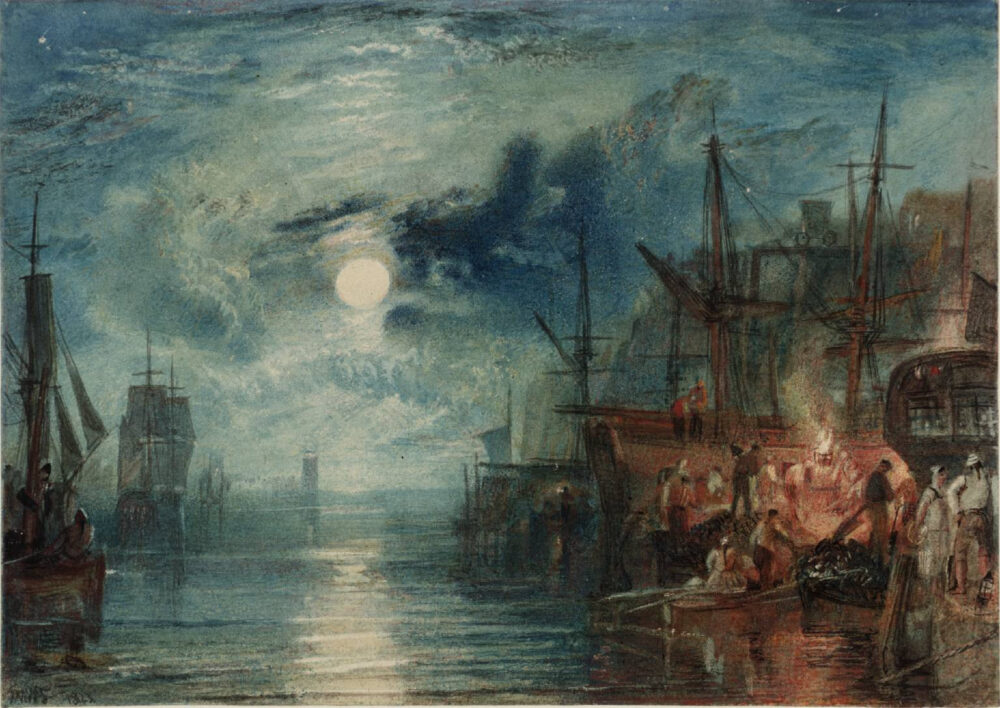
Meaning of Shields on the River Tyne by J.M.W. Turner
In the swirling mists of 19th-century British art, one name rises above most: Joseph Mallord William Turner. Known for his atmospheric seascapes, tempestuous skies, and emotionally charged landscapes, Turner revolutionized the art world with his expressive brushwork and daring treatment of light and color. Among his many works, one painting, Shields, on the River Tyne, stands as a quiet yet poignant reflection of Britain’s maritime soul during the Industrial Revolution.
Painted in 1823, this evocative piece encapsulates not only a geographical location, the port town of North Shields, located on the River Tyne in northeastern England, but also a cultural moment in time, steeped in symbolism, change, and the mounting tension between nature and industry.
What Is “Shields, on the River Tyne” All About?
To understand this painting, one must first understand “Shields” itself. The name refers to two towns, North Shields and South Shields, positioned on either side of the mouth of the River Tyne, near the North Sea. These ports were crucial hubs for coal shipment, fishing, and maritime trade in the 18th and 19th centuries. North Shields, in particular, emerged as an industrial node, a place where the energy of the Industrial Revolution took physical form in the form of shipyards, docks, and coal staithes.
Turner, an avid traveler and maritime enthusiast, was deeply attuned to Britain’s changing landscape. “Shields, on the River Tyne” was painted during a time when the old pastoral world was giving way to a new industrial future. Yet instead of harsh criticism, Turner’s treatment of the scene evokes complexity and nuance. The painting is not a protest, but a poetic meditation on change.
Who Painted It and How: Turner’s Technique and Vision
J.M.W. Turner (1775–1851) was one of Britain’s most celebrated Romantic painters, often considered a forerunner of Impressionism due to his exploration of light and color. By 1823, when he painted Shields, on the River Tyne, Turner was already a well-established artist and a member of the Royal Academy. He had also traveled extensively, gathering visual and emotional impressions from the coastlines of Britain and continental Europe.
Turner painted “Shields, on the River Tyne” in oil on canvas, and the medium serves him well. Using a palette dominated by silvery blues, ochres, and grays, he captures the hazy atmosphere of the river estuary with his signature expressive brushwork. The painting is part of his broader effort during this time to document Britain’s harbors, often under commission or personal interest. Turner had been working on a series of views of English ports, intended for engravings and publication.
Here, his method was not only to record the landscape but to imbue it with feeling, to elevate the industrial and the mundane into the sublime. The painting was created in his studio, likely based on sketches made during his travels in the region.
What’s Happening in the Painting?
At first glance, Shields, on the River Tyne may appear tranquil or even simple. But beneath the surface lies a rich narrative tapestry. The painting presents a panoramic view of the River Tyne estuary. Here’s what we can see:
Foreground activity: Small boats and sailing vessels dot the water, their masts forming a rhythmic counterpoint against the soft skyline. Mariners and fishermen, barely distinguishable, go about their business, reinforcing the idea of Shields as a working harbor.
The industrial middle-ground: Smoke rises from a distant factory chimney, subtle, not dominant, but undeniably present. Coal, being the life-force of the Industrial Revolution, likely plays a central role here. North Shields was a coal-exporting port, and the vessels seen in the painting are probably “colliers”, ships designed to carry coal.
The ethereal sky and light: True to Turner’s signature style, the sky is not merely backdrop, but a living, breathing character. Sunlight filters through a misty atmosphere, casting a golden veil over the entire scene. This light, ambiguous and shifting, suggests both promise and melancholy.
There’s no overt drama, no crashing waves or stormy skies. Instead, Turner gives us a moment of quiet balance, where nature and industry coexist, perhaps uneasily, but not yet in full conflict.
Symbolism and Meaning: Layers Beneath the Surface
Turner was a Romantic painter, but not in the idealized, pastoral sense. His Romanticism was grounded in reality, he engaged with the modern world, and his works often explore the tension between man and nature, the fragility of human endeavors, and the transience of beauty.
In Shields, on the River Tyne, several symbolic layers come to the fore:
1. Industrialization as Sublime Power
By placing smoke stacks and colliers within the same frame as natural light and water, Turner is acknowledging the sublimity of industry. It’s awe-inspiring, even as it hints at environmental and social consequences. The painting becomes a meditation on humanity’s expanding footprint and our attempt to harness nature for progress.
2. The River as a Symbol of Change
Rivers have long symbolized life, time, and transition. The River Tyne in this painting flows with both literal and metaphorical cargo. It carries the coal that powers factories, the ships that drive trade, and the people whose lives are entwined with the tides. The river becomes a channel of economic energy as well as a symbol of inevitable change.
3. Light as Emotional Weather
Turner’s treatment of light often conveys emotion rather than realism. In this piece, the diffused golden light suggests both nostalgia and hope. It may represent a dying day, or a dawning future. This ambiguity is central to Turner’s vision: he doesn’t tell us how to feel; he invites us to contemplate.
4. Maritime Life as Heroic and Fragile
The tiny figures manning boats or moving along the shore remind us that human life is dwarfed by the systems we build and the forces we engage with. Yet they are also resilient, adapted to their environment. Turner pays quiet homage to the working class without turning the painting into overt social commentary.
Style and Genre: What Type of Art Is This?
“Shields, on the River Tyne” falls under the genre of Romantic landscape painting, but with a strong marine painting influence. It is part of a broader shift during the early 19th century where painters, poets, and thinkers began to question Enlightenment ideals of rationality and control, turning instead to emotion, nature, and the sublime.
Yet Turner’s work is distinctly modern in sensibility. He broke with the rigid, detail-focused style of earlier landscape artists. His work anticipates Impressionism and even Abstract Expressionism in the way he lets mood, movement, and emotion guide the brush.
This painting is not a documentary, but a poetic interpretation, a synthesis of observation and imagination. It occupies a liminal space between topography and metaphor.
Where Is It Now? The Painting’s Location Today
Today, Shields, on the River Tyne is part of the collection of the Tate Britain in London, one of the world’s leading repositories of British art. The Tate holds a substantial body of Turner’s work, including oils, watercolors, and sketchbooks.
Turner bequeathed much of his work to the nation upon his death, and Shields, on the River Tyne is among the many treasures preserved under this legacy. Visitors to Tate Britain can see the painting in the context of Turner’s broader career, offering deeper insight into how it fits into his evolving exploration of light, industry, and nature.
Legacy and Impact: Why This Painting Still Matters
Though less dramatic than some of Turner’s stormy seascapes or mythological visions, Shields, on the River Tyne remains a powerful and evocative work. Its significance lies in its subtlety.
In an age when we are increasingly concerned with climate change, industrial legacy, and the balance between development and sustainability, Turner’s 19th-century vision resonates deeply. He captured a moment of transition, the hinge between the rural and the industrial, the personal and the national.
The painting reminds us that art is not just about beauty, it is about bearing witness. Turner bore witness not only to Britain’s natural grandeur but to its social and economic transformation. His genius lay in making both equally sublime.
Final Reflections: The Quiet Power of “Shields”
To stand before Shields, on the River Tyne is to stand before a mirror of time. The boats may be old, the port transformed, and the coal trade diminished, but the human emotions encoded in Turner’s painting remain.
Hope, uncertainty, labor, ambition, beauty, and loss, they all shimmer in the brushstrokes of this luminous work. Whether seen as a maritime landscape, a socio-economic commentary, or a meditation on light and transience, the painting continues to speak to us across the centuries.
Turner once said, “It is only when we are no longer fearful that we begin to create.” In Shields, on the River Tyne, he gave us a painting born of courage, not dramatic, but contemplative. Not flashy, but quietly revolutionary.
And like the River Tyne itself, Turner’s vision still flows, powerful, reflective, and alive.




